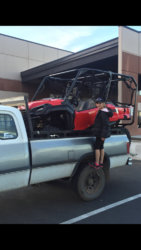HERE ARE SOME NUMBERS:
I'm not a fan of driving the P500 backwards, onto my short-box GMC 2500 Duramax. Some posts on this thread suggest that when you load backwards, you put less weight on the tailgate, more over the axle of the truck etc. I wondered about that. I don't like transporting the P5 backwards; windshield and roof are more like air scoops etc. The P5 is built to drive forward, not backwards.
Tonight I took my rig to the commercial scales and started weighing things. Conventional wisdom has said that 60% of the weight of the P5 is on the rear. I wanted to check, so here goes [ 1 lb = 0.454 kg]:
- My P5 (no passengers): 560 kg (1,233 lbs): front axle 270 kg / rear axle 290 kg [48.2% / 51.8%]
- Truck with P5 loaded backwards: front axle 2,040 kg / rear axle 2,130 kg.
- Truck with P5 loaded frontwards: front axle 2,030 kg/ rear axle 2,140 kg.
So, if I load the P5 backwards, I move 20 kg (44 lbs) off the tailgate. For me, it's not worth it. I prefer driving the P5 frontwards onto the truck and backing it off. I like seeing the truck box as I load, and I can brake before I smack into the end of the box. I prefer transporting P5 front-ways; facing into the wind. Like I said, it was designed to drive forward.
The P5 is pretty well balanced front and back. I understand that your weights may vary. For me the 44 lbs isn't enough of a difference to convince me to transport it backwards on the truck.
FYI: My 2017 P500 has the Honda front and rear bumpers, stick stoppers, Honda roof, a Superwinch 3500S, LEDs and aluminum box on the rear rack with about 20 lbs of gear in it. It was full of gas.
Al




